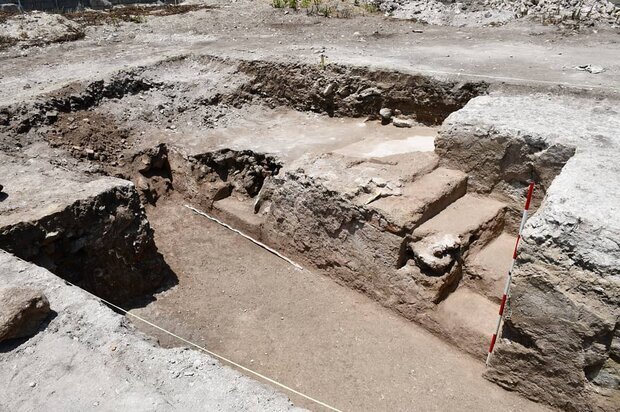Rare Parthian tombstone discovered in northcentral Iran

TEHRAN – A team of archaeologists has recently discovered a rare Parthian-era (247 BC – 224 CE) tombstone in an ancient cemetery in northcentral Iran.
The finding is of high importance because it yielded the “first-ever engraved tombstone of the Parthian era” that has been discovered in Mersinchal cemetery of Semnan province, Mehr quoted archaeologist Ata Hassanpour as saying on Saturday.
The tombstone was discovered during a rescue season carried out at the basin of the developing dam in Mahdishahr county of the province, Hassanpour who led the survey, explained.
Measuring 52 cm in height, 38 cm in width, and 7cm in thickness, the tombstone was located vertically above the head of the deceased, the expert added.
Mersinchal cemetery, which embraces various Parthian tombs, has so far yielded tens of relics discovered inside the tomb chambers as ancient people thought grave goods would be useful to the deceased in the afterlife.
The discovery is of high importance because it yielded the first-ever engraved tombstone of the Parthian era (247 BC – 224 CE). “68 tomb chambers of the type of pit graves were discovered in the cemetery during excavations carried out in the third archaeological season in two phases,” Hassanpour said.
The Parthian Empire, also known as the Arsacid Empire, was a major Iranian political and cultural power in ancient Iran. The Parthians largely adopted the art, architecture, religious beliefs, and royal insignia of their culturally heterogeneous empire, which encompassed Persian, Hellenistic, and regional cultures. At its height, the Parthian Empire stretched from the northern reaches of the Euphrates, in what is now central-eastern Turkey, to eastern Iran.
Parthian wealth obtained through lucrative trade networks resulted in substantial patronage of the arts, in particular, relief sculpture, statuary (large and small scale), architectural sculpture, metalwork, jewelry, and ceramics; coins with images of Parthian rulers form another important category of objects.
Last September, a team of archaeologists and cultural heritage experts commenced an excavation survey on the historical site, trying to retrieve relics before the ancient cemetery sinks into the waters of a dam nearby.
The cemetery bears corps and relics from Medes, a branch of Indo-European people, who entered northeastern Iran probably as early as the 17th century BC and settled in the plateau land that came to be known as Media. And it was also used during the Achaemenid era (c. 550-330 BC), according to Malekzadeh.
Several potteries and personal ornamentations have so far been discovered from the cemetery which bears over 2,000 tomb chambers.
The cemetery at Mersin is located along the southern slopes of the Alborz mountain range, east of the village of Talajim, near Sefidrud River. The site was discovered during a rescue archaeological survey in the Fenisk Dam basin area. Based on surface materials, the cemetery was dated to the late Iron Age III and early Iron Age IV (c. 600–400 BC). To corroborate this dating, a radiocarbon date was obtained from human collagen from several graves.
As the Iron Age culture in Semnan province has not been well recognized, in August 2014 the Iranian Centre for Archaeological Research organized regular excavations at the site under the direction of Malekzadeh. Three trenches were excavated, covering a total of 235 square meters.
Within trench 3 (10×5m) fifteen human graves were found, distributed in a regular pattern. Some burials were disturbed, but common features were easy to recognize, including the rectangular shape of the grave and the presence of a single body buried in each grave, being interred in an extended position on the back. Most graves had large stones delimiting the burial place and all contained grave goods except grave 4 that was, however, disturbed.
The graves can be divided into two general categories, being either covered by large flat slabs and wood (like graves 5 and 10) or covered only by soil. There is no uniform orientation of the body within the burial. Grave goods were variable and there were, among others, pottery vessels of different types, such as single-handled pitchers, bridge spout bowls, pots with spouts and handles, small jars, pedestal bowls, and twin joined small jars.
The main population centers of Semnan province lie along the ancient Silk Road (and modern-day Imam Reza Expressway), linking Rey (Tehran) with Khorasan (Mashhad). While few visitors spend much time in the area, driving through you can easily seek out several well-preserved caravanserais (notably Dehnamak and Ahowan), cisterns (the Cafe Abenbar in Garmsar is a special treat), and ruined mud citadels (Padeh is lumpy but fascinating). The large, bustling cities of Semnan, Damghan, and Shahrud (Bastam) all have a small selection of historic buildings and Semnan has a fine old covered bazaar.
AFM

Leave a Comment